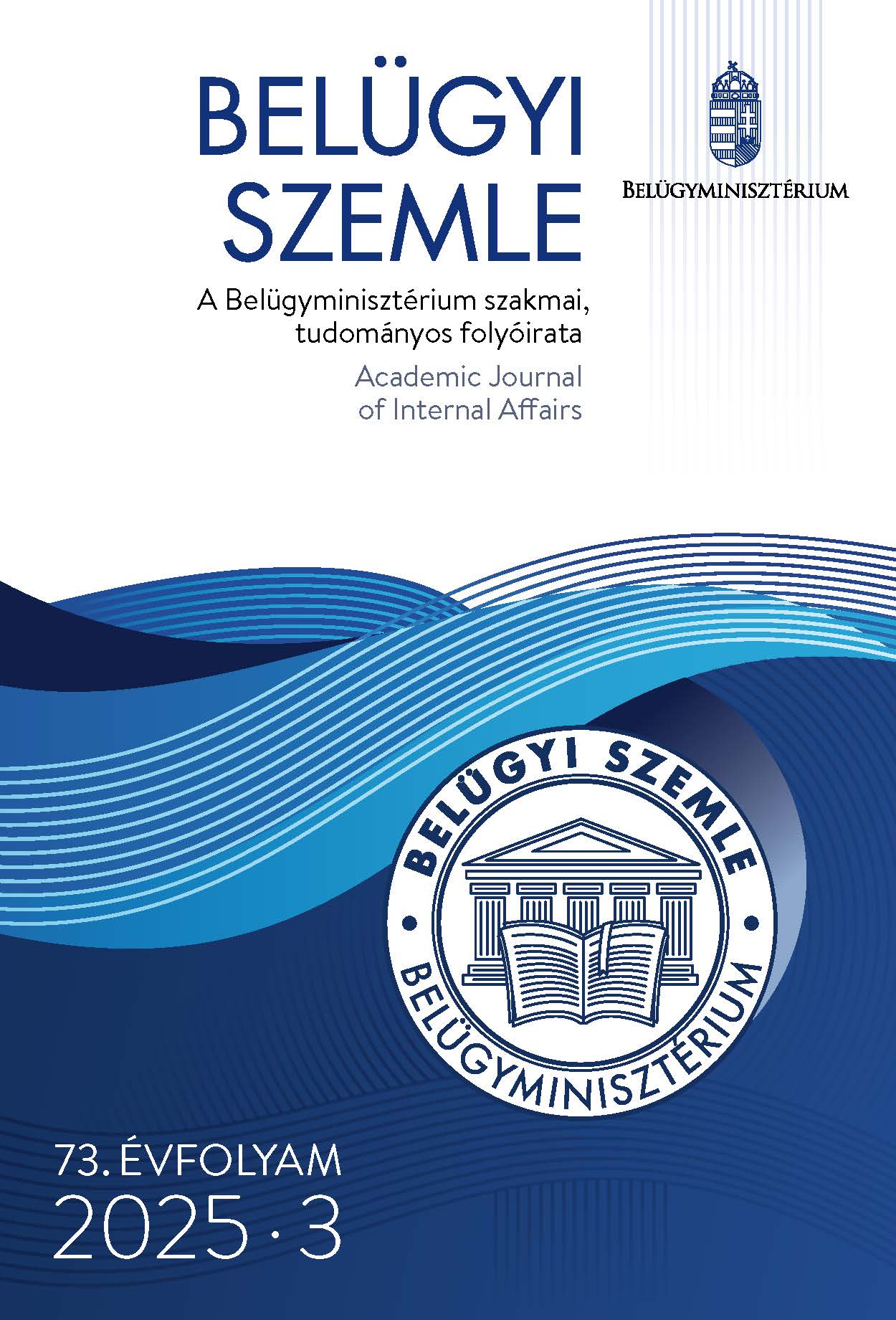Abstract
Aim: Some of the characteristics, geopolitical and security relevance of emerging and disruptive technologies (EDTs) with EU/NATO relevance were discussed briefly in this paper, covering the geo-economic aspects of the subject.
Methodology: National and international literature and statistics databases were surveyed and analysed.
Findings: EDTs play a crucial part in the geopolitical and geo-economic dynamics of our era, posing significant national security threats. The business and government sectors provide different definitions of disruptive technologies, which, in the absence of consultation, may lead to misleading assumptions.
Value: The geopolitical significance of the EDTs and their role in the "Ée" equation was presented. Some of their strategically important security issues were indicated.
References
Bain, R. (1937). Technology and state government. American Sociological Review, 2(6), 860–874. https://doi.org/10.2307/2084365
Bánkuty-Balogh L. (2022). A mesterséges intelligencia elterjedésének geoökonómiai hatásai és Magyarország. Külgazdaság, 66(7–8), 102–130. https://doi.org/10.47630/KULG.2022.66.7-8.102
Béres B., Mozga G., Péti M., & Gossler J. (2017). Az Európai Unió és a magországainak változatos viszonyulása az Új Selyemúthoz és az új kínai gazdasági szerepekhez. In Péti M. (Szerk.), Az Új Selyemút Gazdasági Övezet geostratégiai és földrajzi dimenziói (pp. 65–92). Budapesti Corvinus Egyetem Gazdaságföldrajz, Geoökonómia és Fenntartható Fejlődés Intézet.
Blackwill, R. & Harris, J. (2016). War by other means: Geoeconomics and statecraft. The Belknap Press of Harvard University Press. https://doi.org/10.2307/j.ctt1c84cr7
Bower, J. & Christensen, C. (1995, January–February). Disruptive technologies: Catching the wave. Harvard Business Review, 43–53.
Christensen, C. (1997). The innovator's dilemma: When new technologies cause great firms to fail. Harvard Business Review Press.
Csenger Á. & Eszterhai V. (2021). A konnektivitás mint fegyver: Kína és Ausztrália aszimmetrikus kereskedelmi kapcsolatainak példája. Külügyi Szemle, 20(2), 22–44. https://doi.org/10.47707/Kulugyi_Szemle.2021.2.2
Csizmadia N. (2017). Az új Selyemút geopolitikai jelentősége. In Péti M. (Szerk.), Az Új Selyemút Gazdasági Övezet geostratégiai és földrajzi dimenziói (pp. 37–64). Budapesti Corvinus Egyetem Gazdaságföldrajz, Geoökonómia és Fenntartható Fejlődés Intézet.
Friedman, T. (2005. április 3.). It's a flat world, after all. The New York Times Magazine. https://www.nytimes.com/2005/04/03/magazine/its-a-flat-world-after-all.html
Gaida, J., Wong-Leung, J., & Robin, S. (2023). Critical technology tracker: Who is leading the critical technology race? Australian Strategic Policy Institute. https://techtracker.aspi.org.au
Ghofrani, H., Osterloh, I., & Grimminger, F. (2006). Sildenafil: From angina to erectile dysfunction to pulmonary hypertension and beyond. Nature Reviews Drug Discovery, 5(8), 689–702. https://doi.org/10.1038/nrd2030
Kesteloo, H. (2024. május 29.). Ukraine’s Defense Ministry buys over $27 million in DJI drones. DroneXL. https://dronexl.co/2024/05/29/ukraines-buys-27-million-dji-drones
Khan, K., Su, C.-W., Umar, M., & Zhang, W. (2022). Geopolitics of technology: A new battleground? Technological and Economic Development of Economy, 28(2), 442–462. https://doi.org/10.3846/tede.2022.16028
Kocsis J., Komjáthy D., & Péti M. (2017). Kína Új Selyemút kezdeményezésének bemutatása. In Péti M. (Szerk.), Az Új Selyemút Gazdasági Övezet geostratégiai és földrajzi dimenziói (pp. 13–36). Budapesti Corvinus Egyetem Gazdaságföldrajz, Geoökonómia és Fenntartható Fejlődés Intézet.
Luttwak, E. N. (1990). From geopolitics to geo-economics: Logic of conflict, grammar of commerce. National Interest, 20, 17–23. https://www.jstor.org/stable/42894676
Millet, G. (1986). Cyanoacrylate adhesives. In S. Hartshorn (Ed.), Structural adhesives. Topics in applied chemistry (pp. 249–307). Springer. https://doi.org/10.1007/978-1-4684-7781-8_7
Nindl, E., Confraria, H., Rentocchini, F., Napolitano, L., Georgakaki, A., Ince, E., Fako, P., Hernández Guevara, H., Gavigan, J., Tübke, A., Pinero-Mira, P., Rueda-Cantuche, J. M., Banacloche-Sánchez, S., de Prato, G., & Calza, E. (2023). The 2023 EU industrial R&D investment scoreboard. Publications Office of the European Union. https://dx.doi.org/10.2760/506189
Pető G. (2021). Erőforrás-szűkösség. In Tálas P., Csiki Varga T., Fedorkó B., Kovács K., Lakatos L., Németh B., & Tóth P. (Szerk.), A globalizált világ kihívásai (pp. 51–80). Ludovika Egyetemi Kiadó.
Rotolo, D., Hicks, D., & Martin, B. R. (2015). What is an emerging technology? Research Policy, 44(10), 1827–1843. https://doi.org/10.1016/j.respol.2015.06.006
Sims, D. (2013, March 13). ChatGPT was made possible thanks to tens of thousands of Nvidia GPUs, which Microsoft is now upgrading. Techspot. https://www.techspot.com/news/97919-chatgpt-possible-due-tens-thousands-nvidia-gpus-which.html
Siposné Kecskeméthy K. (2021). A NATO 2030 jelentés – stratégiai prioritások új megközelítésben. Honvédségi Szemle, 149(4), 3–16. https://doi.org/10.35926/HSZ.2021.4.1
Siposné Kecskeméthy K. (2022). Új szinten a partnerségi kapcsolatok a NATO madridi csúcstalálkozó értékelése. Hadtudomány, 32(3), 66–79. https://doi.org/10.17047/HADTUD.2022.32.3.66
Szilágyi I. (2007). A brazil geopolitikai iskola. Politikatudományi Szemle, 16(3), 69–83. Forrás: http://real.mtak.hu/id/eprint/112391
Troxell, J. F. (2018). Geoeconomics. Military Review, 98(1), 4–22. https://www.armyupress.army.mil/Journals/Military-Review/English-Edition-Archives/January-February-2018/Geoeconomics/
Veletsianos, G. (2010). A definition of emerging technologies for education. In G. Veletsianos (Ed.), Emerging technologies in distance education (pp. 3–22). Athabasca University Press.
Zimmermann, A. (2022). R&D funding breakdown: CHIPS and Science Act. AAAS. https://www.aaas.org/sites/default/files/2023-01/CHIPS%20AAE.pdf

This work is licensed under a Creative Commons Attribution-NonCommercial-NoDerivatives 4.0 International License.
Copyright (c) 2025 Academic Journal of Internal Affairs

